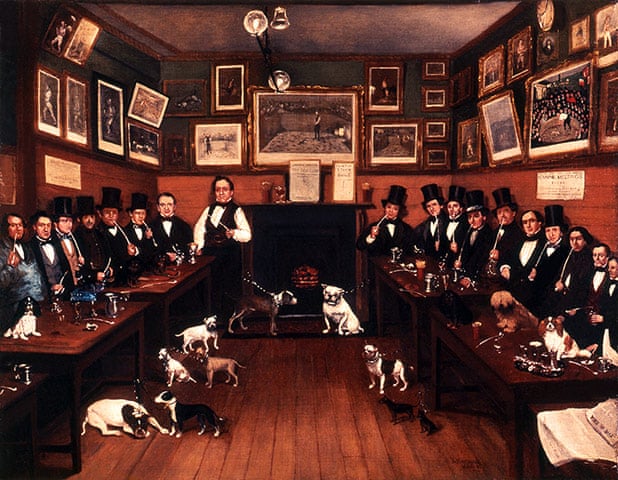R. Marshall. An Early Canine Meeting. 1855.

From:
https://i.guim.co.uk/img/static/sys-images/Lifeandhealth/Pix/pictures/2012/2/2/1328202980863/An-early-canine-meeting-006.jpg?w=1920&q=55&auto=format&usm=12&fit=max&s=cfd88a2cab9bbaae104a969d5e27c044
An early canine meeting: the Queen’s Head Tavern, London, 1855 by R Marshall. This painting is one of the earliest known representations of a dog club and is considered one of the most historic canine paintings. This type of gathering was the predecessor of present-day dog shows. A number of breeds are shown, including a Manchester terrier in the right foreground.
You can see two newspapers lying on a table, bottom right foreground. The artist has painted masthead titles for each, which are: Bell's Life in London; and The Era. Runs of both newspapers are available in the British Newspaper Archive.
James Tissot’s The Last Evening (1873), on display as part of Guildhall Art Gallery
Text cited, with acknowledgments:
From:
https://thehammocknovel.wordpress.com/2014/02/10/tissot-in-the-u-k-london-at-the-geffrye-the-guildhall/
'In The Last Evening (1873, oil on canvas), Tissot depicts a scene fraught with tension. The woman was modeled by Margaret Kennedy (1840 -1930), the wife of Tissot’s friend, Captain John Freebody, (b. 1834). Freebody was the master of the Arundel Castle from 1872-73, and his ship took emigrants to America. He is the younger man in the painting, and Margaret’s older brother, Captain Lumley Kennedy (b. 1819, the master of the Aphrodite in 1872), is the man with the red beard. Tissot exhibited The Last Evening and The Captain’s Daughter (1873, Southampton City Art Gallery) at the Royal Academy in 1873.'
From :
https://www.litro.co.uk/2016/09/communication-nation-victorians-decoded-art-telegraphy-guildhall-art-gallery/
' It is a tangle of unnameable emotions and undefined relationships: a woman in a bath chair, perhaps an invalid, gazes into the middle distance as a sailor wearing a wedding ring addresses her from slightly behind and to the side, his arm curled around her chair in a manner that feels distinctly Mephistophelean. On a deckside bench nearby, another sailor—older and bearded—holds a newspaper, which he’s not reading, between his knees and looks disgruntled. His seat companion, an elderly gentleman with a top hat and watch chain, glances behind him with irritation at something out of view. Meanwhile, a little girl with a black velvet hair ribbon leans over the back of the bench: perhaps trying to read the newspaper that’s held out of her reach, perhaps importuning the elderly man (a grandfather? A guardian?). Behind them all, the riggings of this ship and a dozen others criss-cross the sky in whip-like lines of black paint. It is unspeakably claustrophobic.'



